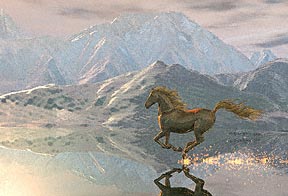
 |
Preface |
What is Prism, and where is it going?
 The version of Prism depicted here is more than a little out of date. Big changes have been made that haven't been integrated to the rules here yet, and more big changes are coming. Most of the changes already made are gathered in the Skill Trees document. This started out as just a "beta-test" document for the new skill tree system, but in the several years since it was written, it has grown to include many other changes, some significant (like the transition from d% to d20, made in 1999), and is now the primary document of Prism as it's being played. If you're here to find out what Prism is like today, that document is where you should be headed.
The version of Prism depicted here is more than a little out of date. Big changes have been made that haven't been integrated to the rules here yet, and more big changes are coming. Most of the changes already made are gathered in the Skill Trees document. This started out as just a "beta-test" document for the new skill tree system, but in the several years since it was written, it has grown to include many other changes, some significant (like the transition from d% to d20, made in 1999), and is now the primary document of Prism as it's being played. If you're here to find out what Prism is like today, that document is where you should be headed.
But if you want to learn Prism as it's being played today, that's very difficult to do. The Skill Trees document mostly assumes the reader is already familiar with v1 (this web site). The best approach is probably to start with the Skill Trees document, glossing over bits that refer to earlier rules, and then go back to the web site to fill in the gaps.
Once a few more rules updates are completed (at a snail's pace, as I cannot dedicate nearly as much time to this as I'd like -- I still have a day job and other things taking up my time), the intent is to do what amounts to a complete rewrite, integrating the changes into a new, complete document. Perhaps the biggest change will be to the style of the writing. The new version will be much less mechanistic and a lot shorter, getting more to the point instead of wasting a lot of time on introducing roleplaying and basic concepts that 99.99% of the audience for Prism already know. (Such introductory material can easily be moved to appendices thanks to the Web, and kept out of the way of those who don't need it.) In a large way this will make Prism look, stylistically, a lot less like the dry and dusty manuals that were in vogue when it was first written back in 1988. (Though I doubt it'll look like the glossy, glitzy, style-over-substance that many modern gaming books use, some well and some poorly. Prism is still more about the substance; mood and style are creative processes usually better handled by the GM than the rules, and Prism is designed to focus on what rules do best and free up people to focus on what they do best.)
 While Prism is getting simpler, it's not becoming a "rules-light" game. There are already plenty of those, and even if I sat down and tried to make a good general-purpose rules-light game, I couldn't do better than already-established games like FUDGE or Risus. I like those types of games for some applications; for instance, PBEMs work best, in my opinion, with a rules-light system (or none at all). In some ways my own Stonepunk game is rules-light as its genre doesn't need more. But for general-purpose everyday gaming in the classic adventure realms, I find a rules-rich game works better. Like a well-equipped toolbox, it's a hindrance when you haven't learned how to use the tools, and a tremendous help when you have. The rules don't "get in the way" of roleplaying -- that's one of the great myths of modern roleplaying. They are meant to assist; if they're not assisting, they're broken, but that's only a condemnation of those rules, not the idea of rules in general. Rules are supposed to take care of the mechanical details so you can focus on the creative details; they inspire ideas, and nudge you out of ruts, and provide the common language and yardstick that avoids assumption clash and other problems that derail the creative process. Prism's maturation doesn't retreat from this philosophy; it brings it into sharper focus.
While Prism is getting simpler, it's not becoming a "rules-light" game. There are already plenty of those, and even if I sat down and tried to make a good general-purpose rules-light game, I couldn't do better than already-established games like FUDGE or Risus. I like those types of games for some applications; for instance, PBEMs work best, in my opinion, with a rules-light system (or none at all). In some ways my own Stonepunk game is rules-light as its genre doesn't need more. But for general-purpose everyday gaming in the classic adventure realms, I find a rules-rich game works better. Like a well-equipped toolbox, it's a hindrance when you haven't learned how to use the tools, and a tremendous help when you have. The rules don't "get in the way" of roleplaying -- that's one of the great myths of modern roleplaying. They are meant to assist; if they're not assisting, they're broken, but that's only a condemnation of those rules, not the idea of rules in general. Rules are supposed to take care of the mechanical details so you can focus on the creative details; they inspire ideas, and nudge you out of ruts, and provide the common language and yardstick that avoids assumption clash and other problems that derail the creative process. Prism's maturation doesn't retreat from this philosophy; it brings it into sharper focus.
 As it always has been, Prism is very character-focused. The bulk of its material concerns making a character, and most of what's left focus on resolving character actions as a natural extension of the work put in earlier to making the character. One thing Prism is coming to emphasize is that the character sheet is as much a reflection of the character as it is a determinant of the character. The reason you set a particular skill at a high or low value isn't simply so that the die rolls will give good or bad results; you also do so to describe the character, round out her details, and know how to play her. If your character has poor social skills (numerically speaking) that will be reflected in how you play her, even when the GM doesn't make you roll against those skills. That line of reasoning doesn't only apply to the intelligence stat; it applies to the whole character, and it is during the whole process of making the character that you should be thinking that way.
As it always has been, Prism is very character-focused. The bulk of its material concerns making a character, and most of what's left focus on resolving character actions as a natural extension of the work put in earlier to making the character. One thing Prism is coming to emphasize is that the character sheet is as much a reflection of the character as it is a determinant of the character. The reason you set a particular skill at a high or low value isn't simply so that the die rolls will give good or bad results; you also do so to describe the character, round out her details, and know how to play her. If your character has poor social skills (numerically speaking) that will be reflected in how you play her, even when the GM doesn't make you roll against those skills. That line of reasoning doesn't only apply to the intelligence stat; it applies to the whole character, and it is during the whole process of making the character that you should be thinking that way.
The first thing people usually say about Prism when describing it to someone else is "it doesn't have a combat system of its own". Technically, that's true, though the initiative system it does have is about half a combat system in actual practice. Why doesn't it have a combat system? That's simple: there are already a lot of good systems out there, and to me it seemed not only a waste of effort, but presumptuous, to spurn those fine creations and make my own offering that probably would be no better. For years, Prism has been at its best when it built on the strengths of other works as well as its own strengths. Nevertheless, I'm happy to say that a combat system for Prism is coalescing, because I finally think that I can make a system, with help from a few others, that's enough of an improvement on what's out there to be worth making.
Right now, my personal favorite system is Iron Crown's Rolemaster™/Spacemaster™ system, but while I like the concepts, there are a few points of implementation that leave something to be desired. In addition, there are two core issues that it doesn't handle, or doesn't handle well: hit locations, and adjustments on the gritty/cinematic scale. I have a few ideas for how to handle these and a host of other smaller improvements, without breaking the remarkable simplicity and speed of that chart-heavy system. (Yes, the widely-panned charts are what make it simple and fast, since they do all the work for you, that other systems like GURPS have to do through pages of rules and special cases.)
One possible direction I'll be pursuing -- I haven't quite made up my mind about this, though -- is making the combat system dependent on the use of a computer. Many people recoil from this idea, but I think the reasons for this antipathy are becoming less relevant every day. The downside of needing a computer handy is minimal; anyone playing Prism certainly has a computer, and more and more have palmtops, webpads, and other easily-transportable, easily-used machines. The advantages, however, are considerable. All existing RPG combat systems make large sacrifices in richness of detail, realism (or genre verisimilitude), strategic options, and suspenseful complexity, all to make sure that combat can play smoothly and quickly enough to sustain the mood. What if the simple addition of a palmtop could give you back all those sacrificed features in spades, while actually making play considerably smoother and faster? If done well (and that's the key -- like so many things in roleplaying, people tend to judge concepts based on previous implementations, not possibilities) this can be less intrusive to mood and setting than dice and character sheets, and a great enhancer to excitement.
 In any case, the combat system will include relevant skills and rules for weapons and armor, including martial arts and related disciplines; a mechanism to integrate all kinds of attacks (melee, firearms, martial arts, and even magic) and other actions into the flow of time in a combat; wounds and recovery rules; rules for called shots, pulled punches, hit locations, rushed or slowed attacks, mixed actions, effects of armor, and other tactical factors. The centerpiece is the initiative system already described here (and updated in the Skill Trees document), the oldest part of Prism (first published in 1988).
In any case, the combat system will include relevant skills and rules for weapons and armor, including martial arts and related disciplines; a mechanism to integrate all kinds of attacks (melee, firearms, martial arts, and even magic) and other actions into the flow of time in a combat; wounds and recovery rules; rules for called shots, pulled punches, hit locations, rushed or slowed attacks, mixed actions, effects of armor, and other tactical factors. The centerpiece is the initiative system already described here (and updated in the Skill Trees document), the oldest part of Prism (first published in 1988).
The combat system isn't all that's changing, though. Here are some more changes planned:
 How soon will all this happen? Probably not soon. The muse keeps whispering in my ear, and I'm eager and anxious to get to work; writer's block is not a problem. But past history is clear that many other things will take time away from this -- not least of which are my efforts to keep working on games for my own group to play. Prism has been around for a long time; the IRIS initiative system and aptitudes were both published as early as 1988 in a 'zine called The Gaming Gazette edited by Otto Kitsinger, and the first printed playtest version followed later that year, with private publication (250 copies sold in total) to follow in 1990, and the web version appearing in 1998. It's been in constant use the whole time and evolving for most of it. So a wait of a few more months is no big deal. But it is happening.
How soon will all this happen? Probably not soon. The muse keeps whispering in my ear, and I'm eager and anxious to get to work; writer's block is not a problem. But past history is clear that many other things will take time away from this -- not least of which are my efforts to keep working on games for my own group to play. Prism has been around for a long time; the IRIS initiative system and aptitudes were both published as early as 1988 in a 'zine called The Gaming Gazette edited by Otto Kitsinger, and the first printed playtest version followed later that year, with private publication (250 copies sold in total) to follow in 1990, and the web version appearing in 1998. It's been in constant use the whole time and evolving for most of it. So a wait of a few more months is no big deal. But it is happening.
I'd love to hear your thoughts on the evolution of Prism. Email me and tell me what you'd like to see.